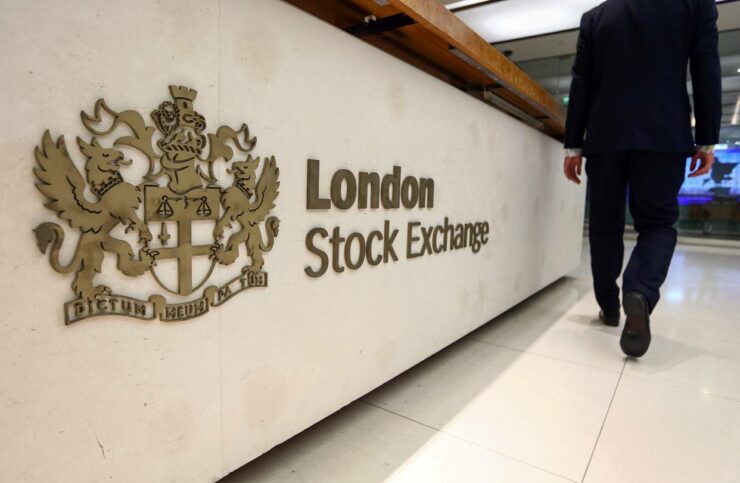Looking to buy, sell, and trade stocks online? If so, there are heaps of brokers active in the online space that allow you to do stock trading with ease. You simply need to find a broker that best meets your needs, deposit funds with a debit/credit card or e-wallet, and you are good to go.
Our Forex Signals
1 - month
Subscription
 Up to 15 signals daily
Up to 15 signals daily 76% success rate
76% success rate Entry, take profit & stop loss
Entry, take profit & stop loss Amount to risk per trade
Amount to risk per trade Risk reward ratio
Risk reward ratiomonth
3 - month
Subscription
 Up to 15 signals daily
Up to 15 signals daily 76% success rate
76% success rate Entry, take profit & stop loss
Entry, take profit & stop loss Amount to risk per trade
Amount to risk per trade Risk reward ratio
Risk reward ratiomonth
 Most popular
Most popular
6 - month
Subscription
 Up to 15 signals daily
Up to 15 signals daily 76% success rate
76% success rate Entry, take profit & stop loss
Entry, take profit & stop loss Amount to risk per trade
Amount to risk per trade Risk reward ratio
Risk reward ratiomonth
Lifetime
Subscription
 Up to 15 signals daily
Up to 15 signals daily 76% success rate
76% success rate Entry, take profit & stop loss
Entry, take profit & stop loss Amount to risk per trade
Amount to risk per trade Risk reward ratio
Risk reward ratioSeparate Swing Trading Group
 Up to 3 signals weekly
Up to 3 signals weekly 76% success rate
76% success rate Entry, take profit & stop loss
Entry, take profit & stop loss Amount to risk per trade
Amount to risk per trade Risk reward ratio
Risk reward ratiomonth
1 - month
Subscription
 Up to 15 signals daily
Up to 15 signals daily 76% success rate
76% success rate Entry, take profit & stop loss
Entry, take profit & stop loss Amount to risk per trade
Amount to risk per trade Risk reward ratio
Risk reward ratiotime
In most cases, stock trading sites give you access to hundreds of equities at the click of a button. This usually includes key markets like the New York Stock Exchange (NYSE), NASDAQ, and the London Stock Exchange (LSE).
3
Payment methods
Trading platforms
Regulated by
Support
Min.Deposit
Leverage max
Currency Pairs
Classification
Mobile App
Min.Deposit
$100
Spread min.
Variables pips
Leverage max
100
Currency Pairs
40
Trading platforms
Funding Methods





Regulated by
FCA
What you can trade
Forex
Indices
Actions
Cryptocurrencies
Raw Materials
Average spread
EUR/GBP
-
EUR/USD
-
EUR/JPY
0.3
EUR/CHF
0.2
GBP/USD
0.0
GBP/JPY
0.1
GBP/CHF
0.3
USD/JPY
-
USD/CHF
0.2
CHF/JPY
0.3
Additional Fee
Continuous rate
Variables
Conversión
Variables pips
Regulation
Yes
FCA
No
CYSEC
No
ASIC
No
CFTC
No
NFA
No
BAFIN
No
CMA
No
SCB
No
DFSA
No
CBFSAI
No
BVIFSC
No
FSCA
No
FSA
No
FFAJ
No
ADGM
No
FRSA
71% of retail investor accounts lose money when trading CFDs with this provider.
Min.Deposit
$100
Spread min.
- pips
Leverage max
400
Currency Pairs
50
Trading platforms
Funding Methods




Regulated by
CYSECASICCBFSAIBVIFSCFSCAFSAFFAJADGMFRSA
What you can trade
Forex
Indices
Actions
Cryptocurrencies
Raw Materials
Etfs
Average spread
EUR/GBP
1
EUR/USD
0.9
EUR/JPY
1
EUR/CHF
1
GBP/USD
1
GBP/JPY
1
GBP/CHF
1
USD/JPY
-
USD/CHF
1
CHF/JPY
1
Additional Fee
Continuous rate
-
Conversión
- pips
Regulation
No
FCA
Yes
CYSEC
Yes
ASIC
No
CFTC
No
NFA
No
BAFIN
No
CMA
No
SCB
No
DFSA
Yes
CBFSAI
Yes
BVIFSC
Yes
FSCA
Yes
FSA
Yes
FFAJ
Yes
ADGM
Yes
FRSA
71% of retail investor accounts lose money when trading CFDs with this provider.
Min.Deposit
$50
Spread min.
- pips
Leverage max
500
Currency Pairs
40
Trading platforms
Funding Methods




What you can trade
Forex
Indices
Actions
Raw Materials
Average spread
EUR/GBP
-
EUR/USD
-
EUR/JPY
-
EUR/CHF
-
GBP/USD
-
GBP/JPY
-
GBP/CHF
-
USD/JPY
-
USD/CHF
-
CHF/JPY
-
Additional Fee
Continuous rate
-
Conversión
- pips
Regulation
No
FCA
No
CYSEC
No
ASIC
No
CFTC
No
NFA
No
BAFIN
No
CMA
No
SCB
No
DFSA
No
CBFSAI
No
BVIFSC
No
FSCA
No
FSA
No
FFAJ
No
ADGM
No
FRSA
71% of retail investor accounts lose money when trading CFDs with this provider.
In this article, we cover the ins and outs of how the online stock trading phenomenon works. Upon reading it in full, you will be armed with all of the necessary tools to get your stock trading career off on the right foot.
Note: Most newbie stock traders lose money at the first attempt, so it is crucial that you have a firm understanding of the risks. As such, we hope that by reading this guide in full, you will have all of the tools required to succeed in the online stock trading space!
Eightcap - Regulated Platform With Tight Spreads

- Minimum deposit of just 250 USD to get lifetime access to all the VIP channels
- Use our Secure and Encrypted Infrastructure
- Spreads from 0.0 pips on Raw Accounts
- Trade on the Award-Winning MT4 & MT5 Platforms
- Multi-jurisdictional Regulation
- No Commission Trading on Standard Accounts

What is Stock Trading?
There is a clear distinction between ‘stock trading’ and simply investing in stocks. If it is the latter, this means that you are looking to buy shares with the view of holding on to them for a number of years. Along the way, you will collect quarterly dividends, and then hopefully unload the stocks at a profit. If this is what you are after, you will need to use a traditional online stock broker.
In the case of stock trading, this is the process of buying and selling stocks on a short-term basis. For example, let’s say that you are feeling bullish on Apple. You might decide to buy £500 worth of stocks and then sell them a few hours later at a profit of 2%. Alternatively, you might be feeling bearish on IBM, so you decide to short-sell its stocks. This is a key component of stock trading, as you have the capacity to make gains if the value of a company’s stock goes down.

Moreover, stock trading sites allow you to apply leverage. This is where you have the capacity to trade with more money than you have in your account. For example, if you buy £100 worth of BT stocks at a leverage of 5:1, the value of your trade would amount to £500. Crucially, stock trading platforms facilitate investments via CFDs (contracts-for-differences). This means that you do not own the underlying stock. On the contrary, you are merely speculating on its future value.
How Does Stock Trading Work?
Stock trading is the process of buying and selling shares on a short-term basis. While some traders rarely keep positions open for more than a few hours, others might hold an investment for a number of days or weeks. Either way, the overarching concept is to either:
- Sell the stocks for a higher price than you paid – if going ‘long’
- Buy the stocks for a lower price than you paid – if going ‘short’.
As such, the first consideration that you need to make when the stock trading is whether you want to go long or short.
✔️ Going Long on a Stock
In its most basic form, going long on a stock simply means you are buying the shares because you think it will increase in price. On this point, this is no different from buying stocks with a traditional broker.
In other words, you hope to sell them for a higher price than you originally paid. If you do decide to go long, you will be required to place a ‘buy’ order at your chosen broker.
Here is an example of how a long stock trade works in practice.
- You are feeling bullish on Nike stocks, so you place a buy order
- Your total stake is $1,000
- The current market price is $85
- A few days later, Nike is priced at $95
- This represents an increase of 11.7%
- To lock-in your profits, you place a sell order
- On a stake of $1,000, an increase of 11.7% translates to a profit of $117 – less fees
As you can see from the above example, your long order was successful because you were able to sell your Nike stocks at $10 higher than you originally paid. In order to lock-in your profits, you were required to place a ‘sell’ order. As such, the trade is closed and the proceeds are added to your stock trading account balance.
✔️ Going Short on a Stock
Unless you are an institutional investor, traditional stock brokers do not allow you to go short on stock. On the contrary, you can only go long. This is why CFD stock trading platforms are so popular with day traders, as they have the flexibility to profit when they believe a company is due to decline in value.
In fact, it is not just companies that you can short in the CFD broker space – as you can trade virtually any asset class imaginable. This includes everything from oil, gas, indices, ETFs, gold, and cryptocurrencies.
Nevertheless, the concept of shorting a stock can often appear confusing for newbie traders, so we have unraveled an example below.
- You are feeling bearish on Facebook stocks, so you decide to place a sell order
- Your total stake is $1,000
- The current price of Facebook is $130
- A few days later, Facebook stocks have plummeted to $102
- This represents a decline of 21.5%
- You decide to lock-in your profits, so you place a buy order
- On a stake of $1,000, a decrease of 21.5% translates to a profit of $210.50 – less fees.
As you can see from the above, you made a tidy profit of 21.5%, because the value of Facebook stocks declined by this amount. In both examples, we noted that your profits would be subject to fees.
This is because your Nike and Facebook positions were held for a number of days. As we cover in more detail later on, stock trading sites will charge you overnight financing fees for each day that you keep your position open.
What Stocks can I Trade?
The best stock trading sites in the online investment space typically give you access to hundreds, if not thousands of equities. This allows you to create a highly diversified portfolio of shares at the click of a button.

New York Stock Exchange (NYSE)
The NYSE is the most traded stock exchange in the world, so it makes sense that online brokers give you unfettered access. Some of the largest blue-chip companies are listed on the NYSE, including the likes of Disney, Berkshire Hathaway, Ford Motors, JP Morgan, Visa, and Nike.
NASDAQ
Not far behind the NYSE is that of NASDAQ. The vast bulk of companies listed on the exchange comes from the world of tech. Think along the lines of Facebook, Apple, Twitter, Netflix, and Microsoft.
London Stock Exchange (LSE)
The LSE is also home to some mega-size companies, including the likes of BP, British American Tobacco, Barclays, HSBC, and Tesco. If you are looking to trade the wider UK economy, it might be worth investing in the FTSE 100 index.
Tokyo Stock Exchange (TSE)
For those of you looking to gain exposure to the Asian economies, the TSE is home to some mammoth stocks. This includes the likes of Soft Bank, Mitsubishi, and Toyota.
Stock Trading and Ownership
As we briefly noted earlier, stock trading sites allow you to buy and sell shares via CFDs. This means that you do not own the stock you are trading. Instead, CFDs allow you to speculate on the future direction of the stock – which is why you have the ability to go long or short.
On the flip side, you will not be entitled to any stockholder rights when trading CFDs, meaning you will not receive dividends. Instead, you will make money through capital gains by buying/selling the stock at a higher/lower price than you paid.
Stock Trading With Leverage and Margin
If you are just starting out in the world of online stock trading, it is crucial that you have a firm understanding of how leverage and margin works. After all, most newbie traders lose money – so you do not want to amplify these losses through leverage.
In its most basic form, leverage allows you to trade with more money than you have in your account. This is expressed as a ratio, such as 5:1. In Layman’s terms, this means that can place a buy or sell order at 5 times the value of your ‘margin’.
The margin operates like a deposit, and it is what allows you to apply leverage. As we cover in more detail shortly, if your leveraged stock trade goes against you by a certain percentage, you stand the chance of losing your margin to the broker.
Before we go any further, let’s look at a quick example of what a successful leverage trade would look like.
Example of a Successful Stock Trade on Leverage
- You are feeling bullish on British American Tobacco (BAT) stocks, so you are going long
- The current market price of BAT stocks is £29.50
- You only have £200 in your account, but you want to trade with more
- As per UK limits, you apply the leverage of 5:1 on your trade
- This means that you place a buy order on BAT stocks worth £1,000
- A couple of days later, BAT stocks increase to £33.50 (13.5%), so you cash-in your profits by placing a sell order
As per the example above, you would have ordinally made a 13.5% profit on your £200 stake, which amounts to £27. However, as you applied leverage of 5:1, your actual profit was £135 (£27 x 5:1)
Example of an Unsuccessful Stock Trade on Leverage
Applying leverage on stock trades will not always go in your favor, as we highlight in the example below.
- To keep things simple, let’s stick with the same examples as above
- To recap – you place a £200 buy order on British American Tobacco (BAT) at the leverage of 5:1
- This means that your trade size is £1,000 – and your margin is £200
- The current market price of BAT stocks is £29.50
- A few days later, BAT stocks go down to £23.60
- As this represents a decline of 20% – which matches the margin that you put forward on the trade (£200 = 20% of £1,000), your trade is ‘liquidated’
- This means that you lose your £200 margin
As you can see from the above, if a leveraged trade goes down by a certain amount, you will lose your entire margin. The only way to avoid being liquidated is to add more funds to your margin account.
In the case of a leveraged trade at 5:1, the margin is 20% (1/5 = 0.2). However, as the leverage increases, the margin decreases. For example, leverage of 20:1 would require a margin of just 5% (1/20 = 0.05). As such, if the stock trade went against you by 5% or more, you would lose your margin.
Stock Trading Orders
We now need to discuss the importance of placing a stock trading order. Each and every trade that you place will always require two individual orders. One to open the trade, and then one to close it.
- If you are going long on a stock, you open with a ‘buy’ order and then close with a ‘sell’ order
- If you are short on a stock, you open with a ‘sell’ order and then close with a ‘buy’ order
Once you have determined whether you are placing a buy or sell order, there are a number of other order types that you are advised to place.
✔️ Market or Limit Order
Regardless of what you are trading, you will always need to choose between a ‘market’ order or a ‘limit’ order.
If opting for a market order, this means that you are happy to take the next available price. Seasoned traders rarely do this, as you lose control over your entry price.
For example, if Nike stocks are worth $85 when you fill out the order, you might have the trade executed at $85.50. This is because the stock trading platform will simply execute the trade at the next available market price.

Sticking with the same example – where Nike stocks are currently priced at $85. Although you are feeling bullish, you might want to enter the market when the price hits $83. This allows you to buy the stocks at a discount, and essentially avoid the initial spread.
✔️ Stop-Loss Order
Without a doubt, a stop-loss order is going to be your best friend when trading stocks online. For those unaware, this allows you to specify the exact price-point that you wish to close your trade. More specifically, it allows you to limit your losses in the event a stock trade goes against you.
For example:
- Let’s say that you are trading IBM stocks, and you decide to enter the market at $112 via a limit order
- Your total stake is $500
- You decide that you do not want to lose more than 5% of your stake, so you set up a stop-loss order
- You set your stop-loss order trigger price at $106.40 – which is 5% less than your entry price of $112
- In the space of one week, IBM stocks are now worth 20% less at $89.60
- However, as you installed a stop-loss at $106.40 – you only lost 5% of your stake.
As you can see from the above, your total losses were reduced to $50 (5% of $1,000 stake), as opposed to $200 (20% of $1,000 stake).
With that said, it is important to note that stop-loss orders are never 100% guaranteed. By this, we mean that in really volatile market conditions, your stop-loss order might not get matched.
As such, it is often worth considering a ‘guaranteed’ stop-loss order. By paying a slightly higher spread, the broker will personally guarantee that your stop-loss price is triggered – irrespective of whether or not it is matched.
✔️ Take-Profit Order
Equally as important, a take-profit order works in the same way as a stop-loss order, but in reverse. In other words, it allows you to lock-in your profits when a certain price-point target is met.
For example, let’s say that you are trading Coca Cola stocks at a buy price of $47. You have set yourself a profit target of 10%, so you set-up your take-profit order at $51.70.
If and when the price of Coca-Cola hits this price, your trade will automatically close – and the proceeds added to your account balance.
Stock Trading Fees
One of the most important metrics to look out for when joining a new stock trading site is the underlying fee structure. This can come in a range of shapes and sizes, so it is best that you have a firm grasp of the main charges you are likely to come across.
Non-Trading Fees
As the name suggests, non-trading fees relate to charges that are not associated with your stock trading endeavors. This starts at the very offset, as some stock trading brokers charge a deposit fee – which is usually a percentage of the amount you deposit.
For example, if the broker charges 1.5% on Visa deposits, and you want to add £1,000 to your account, you will pay £15 in fees. This is often the case with withdrawals, too – so be sure to check before opening an account.
An additional non-trading fee that you need to be aware of is that of an inactivity fee. This is charged by the broker when your stock trading account remains a doormat for a number of months. If it does, the broker will deduct their inactivity fee from your account balance each month until nothing is left.
Stock Trading Commissions
Most, but not all stock trading platforms will charge a commission. In most cases, this will be a percentage of the amount you trade. For example, if the broker charges a commission of 0.5%, you buy £1,000 worth of BT stocks, then you will pay a fee of £5.
Take note, you will need to pay a commission at both ends of the trade. So, if you then sold your BT stocks at a total value of £1,200 – your 0.5% commission would amount to £6.
With that said, most of the stock trading platforms that we have recommended on this page allow you to buy and sell CFD shares without paying any commissions. Instead, it is only the spread that you will need to look out for.
Spreads
Newbie stock traders often make the mistake of forgetting about the spread, as it is not ‘technically’ a fee. By this, we mean that the spread does not deduct any money from your account balance. Instead, the spread is merely the difference between the ‘buy’ and ‘sell’ price of the stock.
For example:
- The buy price of Nike stocks is $85.00
- The sell price of Nike stocks is $83.30
The difference between the two prices is 2% This means that you need to make gains of at least 2% just to break even. For example, let’s say that you placed a buy order on Nike at $85.00 – only to realize that you made a mistake.
As such, you decide to sell the stocks straightaway. However, instead of being able to sell the stocks at the same price you bought them for ($85), you would need to do so at the sell price.
As this amounts to a lower price of $83.30 – you would actually make a 2% loss. Crucially, you would only break even if the sell price increased to $85.
This is why you need to choose a stock trading platform that offers super-tight spreads. Otherwise, your profits will constantly get eaten away by the gap in pricing.
How to Trade Stocks Online?
Never traded a single stock in your life, and wondered how the process actually works? If so, you will find a handy step-by-step guide below. By following the guidelines, you could be trading your first stock in less than 10 minutes!
Step 1: Find a Stock Trading Site
Your first port of call will be to find a stock trading platform that meets your needs. For example, are you looking for a broker that offers access to the international stock markets, or is your main priority fees?
To help you along the way, you will find a number of tips on how to choose a stock trading site further down on this page.
If you do not have time to research a broker yourself, we would suggest the merits of the platform listed below. Not only does it hold a tier-one regulatory license and hundreds of tradable assets, but you can easily deposit funds with a debit or credit card.
Eightcap - Regulated Platform With Tight Spreads

- Minimum deposit of just 250 USD to get lifetime access to all the VIP channels
- Use our Secure and Encrypted Infrastructure
- Spreads from 0.0 pips on Raw Accounts
- Trade on the Award-Winning MT4 & MT5 Platforms
- Multi-jurisdictional Regulation
- No Commission Trading on Standard Accounts

Step 2: Open an Account
Once you have chosen a suitable stock trading site, you will need to open an account. This is so the broker knows who you are.
As such, provide the following:
- Full Name
- Date of Birth
- Home Address
- Nationality
- Contact Details
- Username
- Password
You will also need to verify your identity. This is a minimum requirement in the online stock trading space, as it ensures that platforms comply with anti-money laundering laws. All you need to do is to upload a clear copy of your government-issued ID, and the broker should be able to validate it instantly.
Step 3: Deposit Funds
Once you have verified your identity, the broker will ask you to deposit some funds. In terms of payment options, this will vary from broker-to-broker.
With that said, you often have the choice of funding your account with the following:
Step 4: Find Stocks to Trade
Now that you have funded your broker account, you are ready to start trading stocks. To get the ball rolling, search for the stock that you wish to trade. If you do not have a particular equity in mind, browse through the broker’s stock trading section.
Step 5: Place Stock Trading Order
To complete the process, you will now need to place an order. We discussed the ins and outs of how you place a stock trading order earlier in our guide, so feel free to review the section if you want to refresh your memory.
Otherwise, follow the steps outlined below to get your first stock trade executed:
- Choose from a buy (long) or sell (short) order
- Enter the size of your trade (in your account currency)
- Choose from a market or limit order
- If you want to apply leverage, select your multiple
- Set up a stop-loss order to mitigate your risk
- Set up a take-profit order to lock in your profits
Once you confirm the order, your purchase should be executed within a couple of seconds.
Step 6: Closing Your Stock Trade
If you placed a stop-loss and take-profit order, you will not need to do anything further. This is because only one of two things can happen. You either make money when your take-profit order is triggered, or you lose money when your stop-loss order is triggered.
With that said, if you did not install any exit orders on your stock trade, you will need to close it manually.
- If you placed a buy order, place a sell order to exit your trade
- If you placed a sell order, place a buy order to exit your trade
Once your trade is closed, the proceeds will be added to your stock trading account balance.
How to Choose a Stock Trading Platform
So now that we have explained the ins and outs of how stock trading works, you now need to start thinking about the platform you wish to use. There are literally hundreds of providers in the market, so knowing which broker to sign up with can be challenging.
As such, we would suggest making the following considerations prior to joining a new stock trading site.
✔️ Regulation
Before you even get to metrics like fees, spreads, and payments – you need to ensure that your chosen stock trading platform is regulated. All of the brokers that we recommend hold a tier-one license with bodies like the FCA (UK), ASIC (Australia), or CySEC (Cyprus). If you end up joining a broker that is not regulated, your funds are at risk.
✔️ Payment Methods
You then need to assess what payment methods the stock trading platform offers. Most of our readers prefer depositing funds with a debit or credit card, as this allows you to start trading straightaway. E-wallets are also a good option if you want to benefit from instant deposits.
Alternatively, you might decide to deposit funds with a bank account. Although you will often be entitled to higher limits, the deposit can take a few days before it reaches your account.
✔️ Spreads and Commissions
We prefer stock trading platforms that offer the perfect combination between tight spreads and low commissions. For example, some of our top-rated brokers offer commission-free trades, but then you might that the spreads are slightly higher than other platforms. Similarly, a small number of brokers offer zero-spreads on major stocks, but commissions are often on the high side.
✔️ Leverage Limits
If you are looking to trade stocks with leverage, you will need to ensure that your chosen broker supports this. Depending on your location, you might be limited in how much leverage the broker can offer you. For example, those based in the UK and European Union are capped at 5:1 on stocks. Some nations impose no limits at all, so you often find brokers offering leverage of up to 500:1, which is huge.
✔️ Education and Research
If you are looking to buy and sell stocks on a short-term basis, it is absolutely crucial that you utilize research tools. In the case of technical analysis, you will want to use a stock trading site that offers heaps of advanced chart reading tools. The fundamentals are equally as important in the world of stocks and shares, so opt for a broker that offers real-time news and trading tips.
✔️ Tradable Markets
Have you thought about the types of stocks that you wish to trade? For example, while some of you might be happy trading UK equities via the London Stock Exchange, some of you might want access to international markets. As such, be sure to check the number of stocks hosted by the broker, and in particular, which exchanges it gives you access to.
✔️ Withdrawal Times
Also overlooked by newbie stock traders, you need to check the withdrawal policy of your chosen broker. This boils down to the number of hours or days the broker takes to process withdrawals. We would suggest sticking with stock trading sites that process cashouts no later than 48 hours after the request has been made.
✔️ Customer Support
You should also explore the customer support department. We prefer stock trading platforms that offer support on at least a 24/5 – subsequently matching that of the financial markets. We also like it when brokers allow you to make contact via live chat, as this avoids the need to call a non-toll-free number.
5 Best Stock Trading Brokers of 2023 – Our Top Picks
If you do not have time to research a broker yourself, below you will find our top five stock trading site recommendations of 2023.

- Regulated by a tier-one licensing body.
- Low fees, spreads, and commissions.
- Supports everyday payment methods.
- Top-notch customer service team.
- Offer leverage and short-selling.
1. AVATrade – 2 x $200 Forex Welcome Bonuses
The team at AVATrade are now offering a huge 20% forex bonus of up to $10,000. This means that you will need to deposit $50,000 to get the maximum bonus allocation. Take note, you will need to deposit a minimum of $1,000 to get the bonus, and your account needs to be verified before the funds are credited. In terms of withdrawing the bonus out, you will get $1 for every 0.1 lot that you trade.

- 20% welcome bonus of upto $10,000
- Minimum deposit $1,000
- Verify your account before the bonus is credited
2. VantageFX – Ultra-Low Spreads
VantageFX VFSC under Section 4 of the Financial Dealers Licensing Act that offers heaps of financial instruments. All in the form of CFDs - this covers shares, indices, and commodities.
Open and trade on a Vantage RAW ECN account to get some of the lowest spreads in the business. Trade on institutional-grade liquidity that is obtained directly from some of the top institutions in the world without any markup being added at our end. No longer the exclusive province of hedge funds, everyone now has access to this liquidity and tight spreads for as little as $0.
Some of the lowest spreads in the market may be found if you decide to open and trade on a Vantage RAW ECN account. Trade using institutional-grade liquidity that is sourced directly from some of the top institutions in the world with zero markup added. This level of liquidity and availability of thin spreads down to zero are no longer the exclusive purview of hedge funds.

- The Lowest Trading Costs
- Minimum deposit $50
- Leverage up to 500:1
Conclusion
If you are looking to take your stock trading endeavours to the next level, we hope that our super in-depth guide has cleared the mist. Crucially, we have covered all of the requirements that we think you need to be made aware of before placing a trade.
This includes everything from the spread, regulation, commissions, leverage, and orders. Moreover, we have also discussed five of our top-rated stock trading sites of 2023.
Regardless of which platform you decide to sign up with, just make sure you understand the risks of buying and sell stock CFDs – especially if you are planning to apply leverage.
Eightcap - Regulated Platform With Tight Spreads

- Minimum deposit of just 250 USD to get lifetime access to all the VIP channels
- Use our Secure and Encrypted Infrastructure
- Spreads from 0.0 pips on Raw Accounts
- Trade on the Award-Winning MT4 & MT5 Platforms
- Multi-jurisdictional Regulation
- No Commission Trading on Standard Accounts

FAQs
Will I get dividends when trading stocks online?
What is the minimum amount I can invest at a stock trading site
Why do I need to upload ID when trading stocks online?
What deposit fees do I need to pay when trading stocks?
How do I short-sell stocks?
Can I trade stocks with leverage?
What payment methods can I use to deposit funds at a stock trading site?


